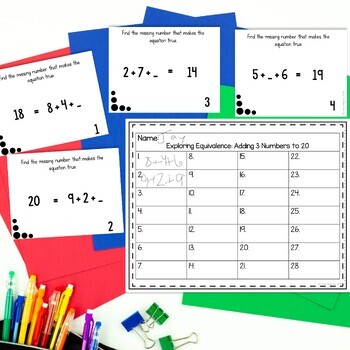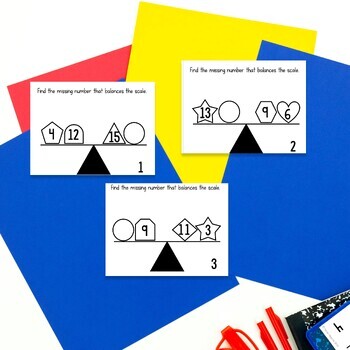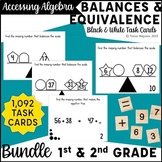Addition and Subtraction within 20 Task Cards Missing Addend Balancing Equations
- Zip
Products in this Bundle (13)
showing 1-5 of 13 products
Also included in
- These Addition and Subtraction Missing Addends Algebra Task Cards help reinforce the concept of equality while deepening students' understanding of addition and subtraction. There are two types of formats included: balances and equations. These reinforce the concepts of "equal" and addition and subtPrice $46.99Original Price $63.00Save $16.01
Description
These First Grade Accessing Algebra Task Cards are the perfect way to integrate addition, subtraction, and equality while building fluency with facts within 20, challenging students to apply their learning of the operations in new ways! Equality can be a difficult concept for students, but it is an integral part of 1st grade math instruction.
Are you looking for enrichment resources to help your students practice addition and subtraction within 20? These Balancing Equations, Exploring Equivalence, and Function Tables task cards are the perfect rigorous activity for your high flyers and fast finishers! Have each task card set accessible for students to work to challenge themselves to apply the operations in new ways.
Students build their algebraic thinking with equivalence by working through balance the equation and equality activities. By integrating algebraic concepts in elementary classrooms, students develop math reasoning and computation skills while applying number sense, logic, and algebraic thinking.
WHAT'S INCLUDED:
676 Task Cards broken into 13 products
Adding 3 Numbers to 20
Balancing Equations: Adding 3 Numbers
Exploring Equivalence: Adding 3 Numbers
Balancing Equations: 2 Step Adding 3 Numbers
Exploring Equivalence: 2 Step Adding 3 Numbers
Addition & Subtraction within 20
Balancing Equations: 1 Step Addition
Balancing Equations: 2 Step Addition
Exploring Equivalence: Missing Addends
Exploring Equivalence: Missing Subtrahends
Exploring Equivalence: Mixed Addition & Subtraction Missing Number
Exploring Equivalence: 2 Step Missing Addends
Exploring Equivalence: 2 Step Missing Subtrahends
Exploring Equivalence: 2 Step Mixed Addition & Subtraction Missing Number
Function Tables: Applying Rules in Addition & Subtraction
Each product includes
- 2 sets of 28 task cards
- Recording sheet
- answer key
Once students understand the concept using the balance to represent the equation, they are ready to move into equations with a missing number. Once it’s introduced, these are a great extension for fast finishers, and even high ability students depending on the grade level.
I intentionally left these task cards and the recording sheet somewhat open ended. This allows you to tailor your directions to match your students’ readiness levels. You can have students just identify the missing number write an equation, and/or use a variable.
If you have not worked with equality previously, students will likely need some instruction for beginning. Once it’s introduced, these are a great extension for fast finishers, and even high ability students depending on the grade level.
These task cards are great for:
- whole class instruction
- small group instruction- both guided or independent
- math stations or math centers
- fast finisher extensions
- high ability extensions
- enrichment
- reinforcement
These task cards are part of my Accessing Algebra line. Accessing Algebra is designed to focus on applying algebraic thinking with our existing standards, giving students the tools they'll need for success later. By looking at the standards in a new way, students build a deeper understanding of the standard while also building their critical and algebraic thinking.
CLICK HERE to follow me and be notified of future products as soon as they are posted.
_______________________________________________________________
Copyright © Tessa Maguire.
Purchase is for single classroom use only. Please purchase additional licenses if you intend to share this product with colleagues.
You may not redistribute, edit, sell, or otherwise post this product on the internet. You may, however, post a link for others to purchase themselves.






